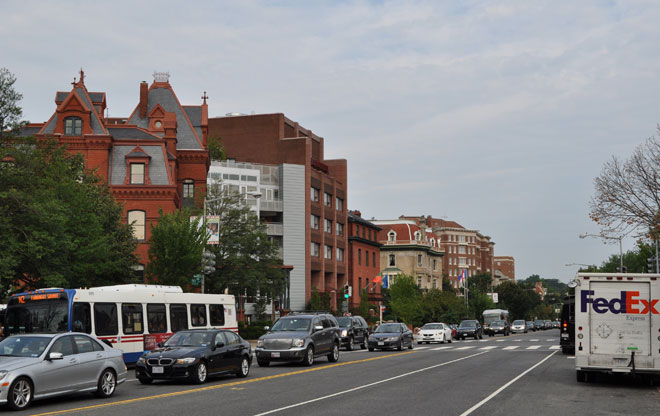
Streetscape with Urban Edge
At Dupont Circle embassy buildings are interspersed with commercial and institutional buildings of varying size and scale both historic and contemporary. The tight street grid of this span of Embassy Row means many buildings showcase parking spaces more prominently than plantings. These Embassies tend to feel more approachable because of their scale and proximity to the street.
Image: Michael Vergason Landscape Architects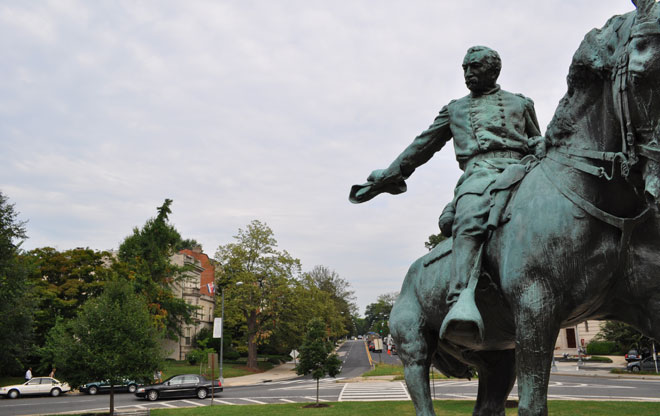
Sheridan Circle
Sheridan Circle feels like a ceremonial park that fits into L’Enfant’s vision for the city of Washington, even though it lies just outside the bounds of the original 1791 plan. At its center is a bronze statue of Civil War General Philip Sheridan, created by sculptor of Mount Rushmore, Gutzon Borglum. It is also hub that connects easily with the Dumbarton Bridge and identifies the point where Massachusetts Avenue changes direction to align with Rock Creek. The lack of accessible pedestrian routes, benches and trees, however, prevents this space from being as lively or as visited as Dupont Circle.
Image: Michael Vergason Landscape Architects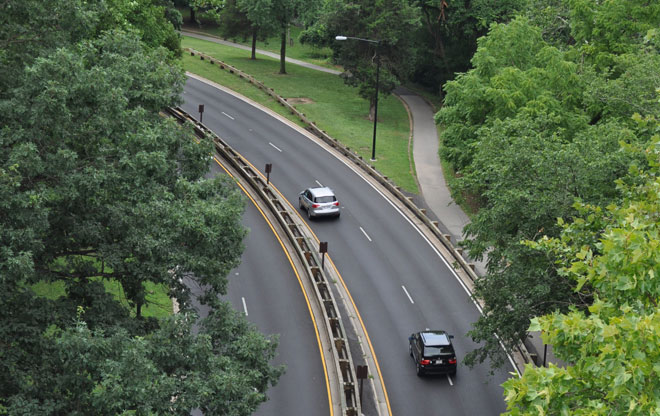
Crossing the Park
Crossing the bridge over Rock Creek allows one to appreciate some of the dramatic topography in Washington, D.C. Standing on the Massachusetts Avenue bridge, one can look down the forested ravine to see the flow of the creek, its trails and the Rock Creek Parkway. The bridge is also a transition point after which there is a more generous building setback, allowing for more interesting and lush gardens with a wider sidewalk.
Image: Michael Vergason Landscape Architects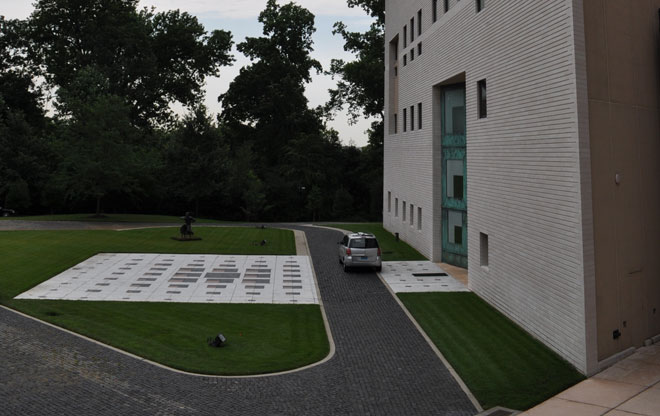
Italian Embassy
Just off Massachusetts Avenue to the east on Whitehaven Boulevard lies the Modernist and eye-catching Italian Embassy. Keeping with the more suburban or campus-like quality of this section of Embassy Row, it has generous grounds of lush plantings, hidden below ground parking, tree-lined streets, wide sidewalks and typically more than one building in each compound. Despite its distance from the street, the Italian Embassy welcomes pedestrians to view its minimalist, manicured grounds through a glass railing.
Image: Michael Vergason Landscape Architects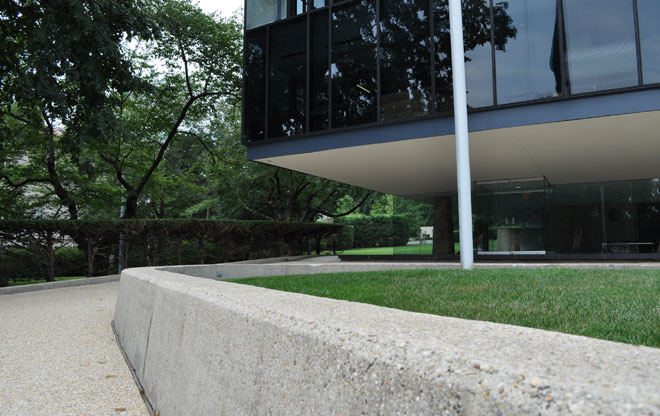
Brazilian Embassy
The Brazilian Embassy is striking from afar due to its modern design and glass façade that reflects a mirror image of the nearby trees. Its proximity to the street welcomes visitors and its glass walls and door at the entry blur the lines between interior and exterior space.
Image: Michael Vergason Landscape Architects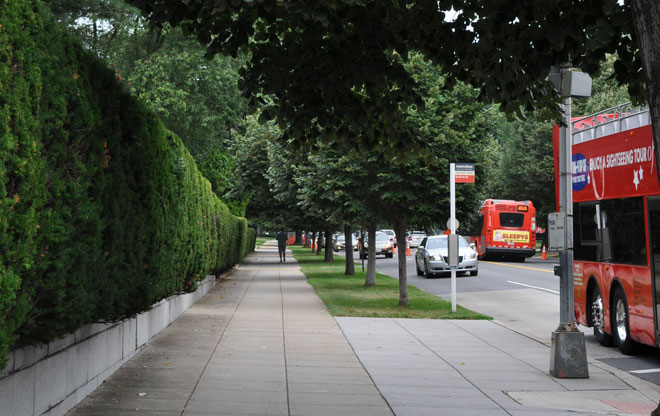
Lindens along Embassy Row
A continuous line of dense-canopied linden trees defines the edge of Massachusetts Avenue’s western sidewalk between Rock Creek Park and Observatory Circle. The canopy cover provides a feeling of enclosure and protects pedestrians from the hot summer sun. The wider sidewalk in this section of Embassy Row has a park-like feeling that encourages walking at a leisurely pace.
Image: Michael Vergason Landscape Architects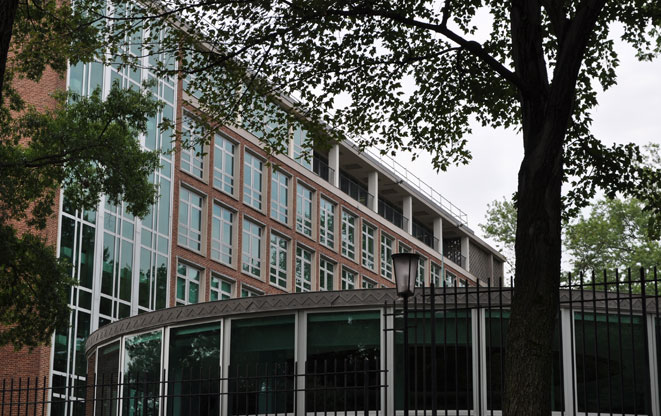
British Embassy
Showing finesse and sensitivity between landscape and buildings, the British Embassy is a beautiful period piece and the only work in the U.S. by the great Edwin Lutyens, one of my favorite early 20th century architects. The embassy addition completed in 1960 is an unusual example of mid-centuty Modern design with a humane touch often missing in work of that period. The recent construction of brick planters in the name of security is an unfortunate addition to an otherwise exquisite ensemble of buildings.
Image: Michael Vergason Landscape Architects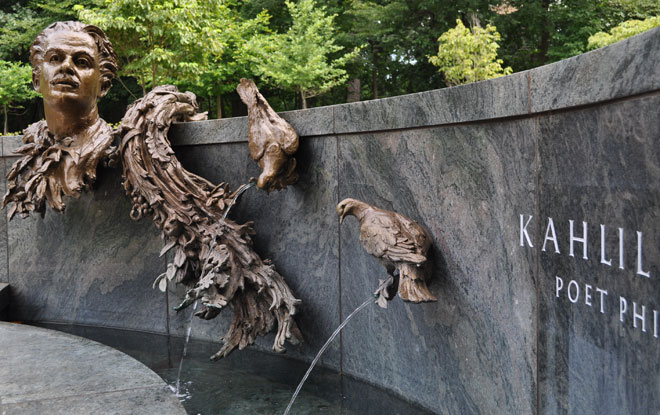
Kahlil Gibran Statue
Shrouded amidst canopy trees on the north side of Massachusetts Avenue, the memorial garden to Lebanese-American poet Kahlil Gibran offers a much different atmosphere than the memorials of the monumental core. Unlike those highly trafficked classical works, this is a solitary, contemplative space surrounded by forest with winding paths, benches and a bubbling fountain.
Image: Michael Vergason Landscape Architects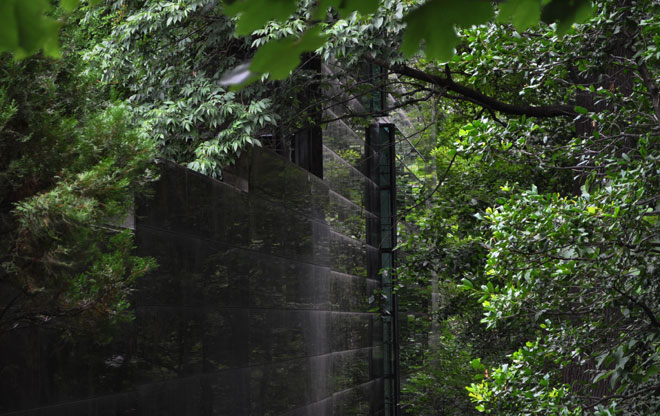
Finnish Embassy
The Finnish Embassy is worth visiting because it does not conform to the standards of embassy design in Washington, D.C. Built in 1994, it does the most to maximize its relationship to the site by revealing the forest through large glass exterior walls and reflecting the forest on the polished stone exterior. It’s most distinguishing features seen from the street are the screen of climbing vines and finishes of bronze patina.
Image: Michael Vergason Landscape Architects